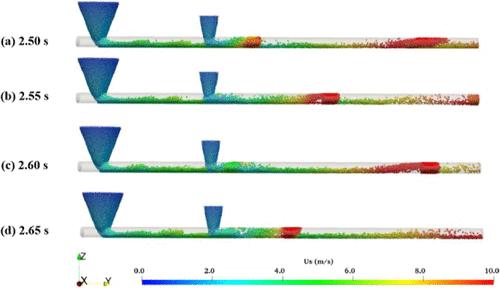密集水平气力输送过程中尺度段塞特性研究
IF 3.9
3区 工程技术
Q2 ENGINEERING, CHEMICAL
引用次数: 0
摘要
高密度气力输送中的段塞行为会影响系统的稳定性和效率,因此迫切需要深入了解这一现象。本研究采用计算流体力学与离散元方法相结合的方法,综合分析了水平密相气力输送系统中段塞和颗粒的行为和特性。在验证模型的基础上,研究了不同工况下段塞流的速度、体积、颗粒轨迹、分散等特性,考察了它们的特征和变化规律。研究结果表明,表面气速是影响气力输送效率的关键因素。当表面气速从8 m/s增加到12 m/s时,段塞流速度增加了53.60%,管道中点处的体积减少了70.12%。较高的颗粒流量显著提高了段塞流速度,同时减小了段塞流的频率和体积。颗粒尺度信息对段塞流行为有明显的影响。较低的颗粒密度使它们更容易被鼻涕虫捕获和丢弃。因此,泡沫聚丙烯(FPP)颗粒的最大分散和位移分别达到1.64 m2/s和0.30 m,而陶瓷颗粒的最大分散和位移仅为0.71 m2/s和0.13 m。通过对段塞的深入分析,为优化水平密相气力输送系统提供了有价值的依据。本文章由计算机程序翻译,如有差异,请以英文原文为准。

Insight into the Mesoscale Slug Characteristics in the Dense Horizontal Pneumatic Conveying Process
Slug behavior in dense pneumatic conveying affects system stability and efficiency, which raises the urgent need for an in-depth understanding of this phenomenon. This investigation employs computational fluid dynamics coupled with a discrete element method to comprehensively analyze the behavior and properties of slugs and particles within a horizontal dense-phase pneumatic conveying system. Based on the validated model, this study explores slug velocity, volume, particle trajectory, dispersion, and other properties under diverse operating conditions, examining their characteristics and variation patterns. The findings indicate that the superficial gas velocity is a key factor affecting the efficiency of pneumatic conveying. As the superficial gas velocity increases from 8 to 12 m/s, a 53.60% increase in the slug velocity and a 70.12% decrease in the volume are observed at the midpoint of the pipe. Higher particle flow rate significantly increases the slug velocity while reducing the frequency and volume. The particle-scale information has an obvious effect on slug behavior. The lower density of particles makes them more easily caught and discarded by the slugs. Consequently, the maximum dispersion and displacement of foamed polypropylene (FPP) particles reach 1.64 m2/s and 0.30 m, respectively, whereas those of ceramic particles are only 0.71 m2/s and 0.13 m. These findings provide a valuable basis for optimizing the horizontal dense-phase pneumatic conveying system through an in-depth analysis of the slug.
求助全文
通过发布文献求助,成功后即可免费获取论文全文。
去求助
来源期刊

Industrial & Engineering Chemistry Research
工程技术-工程:化工
CiteScore
7.40
自引率
7.10%
发文量
1467
审稿时长
2.8 months
期刊介绍:
ndustrial & Engineering Chemistry, with variations in title and format, has been published since 1909 by the American Chemical Society. Industrial & Engineering Chemistry Research is a weekly publication that reports industrial and academic research in the broad fields of applied chemistry and chemical engineering with special focus on fundamentals, processes, and products.
 求助内容:
求助内容: 应助结果提醒方式:
应助结果提醒方式:


